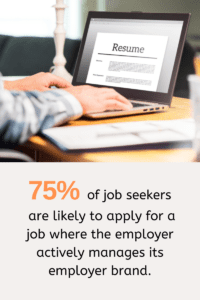Organizations with a brand that can withstand adversity are more likely to be successful in attracting and retaining key talent.
By Zee Johnson
As it’s said, tough times call for tough measures. And in today’s climate where the world could change drastically at a moment’s notice, leaders must be able to confidently confront unforeseen difficulties that could tarnish an organization’s reputation, like hiring freezes and lay-offs.
But tough calls shouldn’t be made without proper planning and preparation. The best way to plan for hardships and remain an employer of choice in the eyes of both job seekers and current employees is by carefully crafting an employee value proposition (EVP).
A LinkedIn survey found that 59% of recruitment professionals are increasing their employer brand spend and 75% of job seekers are likely to apply for a job where the employer actively manages its employer brand. In order to sustain appeal-especially during down times-organizations must be in front of their messaging and image.
An employer brand rooted in a strategic EVP can help mitigate reputation risk and be a catalyst behind a favorable employee experience, from beginning to end. “An employer brand should be leveraged in communication not just in TA but also across multiple touchpoints in the employee journey, from onboarding to exit, to remind talent of why they are here in the first place and what drew them to choose a particular company for employment,” says Ankita Sancheti, Vice President, Brand and Digital at Cielo.
 Sancheti also notes that a laser focus on engagement and communication-two factors that have helped organizations come out on the other side of turmoil-is critical to easing employee fear during uncertainty while instilling trust.
Sancheti also notes that a laser focus on engagement and communication-two factors that have helped organizations come out on the other side of turmoil-is critical to easing employee fear during uncertainty while instilling trust.
Marco Abato, Senior Vice President, Brand and Digital at Cielo, also understands that communication is key, but he urges organizations to take it a step further. “I would also challenge employers to continue promoting their employer brand through awareness efforts. This is not always an easy decision, and refined targeting to reach specific audiences is likely required. However, time and time again, we see that brands that cut outreach during a down economy tend to lose awareness and brand recognition compared to those who continue awareness efforts.”
Both executives agree that to bolster a strong EVP and therefore strengthen TA efforts, some proven initiatives include:
- Developing or enhancing an employee ambassador program to promote the employer brand and culture while focusing on key talent areas. This is also a great way to retain current talent.
- Reviewing the candidate experience through the career site and application process, including content evaluation, job search functionality, and application time. Abato says a down economy is the perfect time to invest in this area.
- Keeping in contact with candidates via email, social media, and other channels to keep them engaged in case future opportunities arise.
Though adversity will be experienced by almost every company, maintaining a reputable brand can make a difference during all hiring cycles. “Reputation management is a key element of the employer brand strategy that should be a focus for TA,” Sancheti says. “While hiring may not be a key focus, a bad reputation can have ripple effects that can impact hiring at later stages.”














